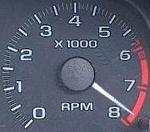1. / One Formula: David Vizard's Rule for IM Runner Length
The general rule is that you should begin with a runner length of 17.8 cm for a 10,000 rpm peak torque location, from the intake opening to the plenum chamber. You add 4.3 cm to the runner length for every 1000 rpm that you want the peak torque to occur before the 10,000 rpm.
So, for instance, if peak torque should occur at 4,000 rpm the total runner length should be 17.8 cm + (6 x 4.3 cm) = 43.6 cm.
Vizard also suggests that you can calculate the ideal runner diameter by the equation :
SQRT [ (target rpm for peak torque x Displacement x VE)/ 3330 ]
SQRT = square root
VE = Volumetric Efficiency in %
Displacement in Liters
given the total length of runner lentgh ie: IM+head= peak tork is at 6500rpm
now given this formula of intake diameter a stock ln2 IM is 1.45" (it should be 2.01 to match the runer) thus createing peak torque at around 3500 rpm
factor this together (lengh+dia / 2) = rated torque on factory IM is 5000 rpm with portmatching IM+head peak is raised to 5750rpm
The best way to find out if your TB is too small for your IM plenum is to determine what the intake manifold absolute pressure (MAP) sensor is reading (in the plenum) when you are at full throttle ( or wide open throttle (WOT) ) while the car is accelerating using a datalogger. The MAP should be equal to, or close to, atmospheric pressure. If it isn't or there is a MAP drop at WOT, then your TB is still too small.
But as with ln2&2200 chevy engines the stock TB is more than adequate to provide enough power unless u runing biger than 1.77" IM runners
Once u have determined the optimal TB size for your IM, we can then determine the best intake inner diameter.
The ideal diameter for an intake is when the intake has 25% more cross-sectional area than the TB's bore cross-sectional area . Your TB diameter (overbored or not) dictates your intake diameter.
Remember that the area of a circle (your TB bore) is pi x radius squared and the diameter = 2 x radius. If you calculate your TB's area and then multiply it by 1.33, you will determine the intake's area. Then, use the area of the circle equation to determine the intake's radius.
Therefore, for example, with a 64mm (plate side bore) TB, the calculated "best" intake diameter is 2.8 in. ID.
LENGTH OF RAM INTAKE TUBE
A suggested starting point for the length of a tube with peak torque at 6000 rpm is 13 in.
You add 1.7 in. for every 1000 rpm that you want to move the peak torque below 6000.
Or subtract 1.7 in. for every 1000 rpm you want to move the peak torque above 6000.
when u factor in this plus what i posted on exhaust&header tuning u will ultimatly see the most gains and potential and avoid spending tons of money when u dont even need to in the aspect of makeing horsepower.
our engines as said time and time again are big air pumps with proper int & exh tuning itl do more for your engine than anything else u bolt on.
if it start the next day it can be driven harder
Lol, From profile
95gtzspec2's Profile wrote:
Miscellaneous:
* i dont plan on running my car past 300 hp on on forced induction only a 50 shot of nos so its there when needed as is the ln2 motor was not designed to handle more then 300
I'm pretty sure there are only a handful of people who have managed to creep the LN2 past 300. If that.
You do realize that you are sitting on about 95-105 hp tops right?
Edited 2 time(s). Last edited Wednesday, August 05, 2009 7:41 PM

there arent very many people that use theories like the one stated above, well f1 enginees im sure do and maybe automitve engineers but thats about it........... lets keep it simple........... long runners are good for an all motor/DD application where u want more under the curve and short runners are good for a turbo application because of its high rpm capabilites where the turbo is more efficant.......... and port runners = more flow and non ported runners = not as much flow. ive been building intakes for about 4 years now and ive never used that formula....... ive looked at it a few time but i think the one time i put numbers in, it came out telling me the ideal runner length was 17" or something rediculous. so i just quit there with that one.
mike
Edited 1 time(s). Last edited Wednesday, August 05, 2009 7:59 PM
i make neons go fast.........

^^Can you get me a cheap 2.2 flange?^^

Mike (96RedCav) wrote:^^Can you get me a cheap 2.2 flange?^^
yeah im sure i could but not for very cheap.
mike
i make neons go fast.........

That's why I like my car. Moar copypasta:
Toyota Variable Induction System, or T-VIS, is a variable intake system designed by Toyota.
It improves the low-end torque of high-performance, small displacement four-stroke engines by changing the geometry of the intake manifold according to the engine rotation speed. The system uses two separate intake runners per cylinder, one being equipped with a butterfly valve that can either open or close the runner. All valves are attached to a common shaft which is rotated by a vacuum actuator outside the manifold.
The engine control unit allows vacuum into the actuator by powering a solenoid valve when the engine rotation speed is below 4200 RPM. Above this engine speed vacuum is cut off and a spring inside the actuator causes the butterfly valve to fully open. The theory behind the system is that in the lower engine speed band, the speed of the intake air will be increased because the intake runner cross section per cylinder is smaller. However, when engine speed increases, the second runner is opened, decreasing airflow speed, but increasing the airflow volume, better matching the engine's airflow needs at higher RPM. With modified engines (more flow) it may be desireable to have the T-VIS open earlier than stock because it begins to restrict the airflow at a lower RPM, since the airflow per RPM is greater with upgraded turbochargers, intake, and exhaust systems.
It's like VTAK for your intake y0! Seriously though, it really helps the car at the above stated 4200 rpm, and eliminates the need for an aftermarket intake manifold. All I need is a bigger throttle blade and the intake itself, and my intake system is complete. The downside is Toyota did a great job designing everything on this engine, so typical bolt ons won't net me much power.
2010 Honda Fit LX
Mike (96RedCav) wrote:
I'm pretty sure there are only a handful of people who have managed to creep the LN2 past 300. If that.
Yes, there is.
TurboS10.com has already met & surpassed that mark, and are still shootin' for more... Like 600hp!
Sorry guys, they're only making kits for LN2'd S-trucks. So....
Go beyond the "bolt-on".
Link fail, How many are actually running over 300?
I know they can get close with a turbo and mild build. But there are almost no people willing to get that far into these motors.

Mike (96RedCav) wrote:Link fail, How many are actually running over 300?
I know they can get close with a turbo and mild build. But there are almost no people willing to get that far into these motors.
Here, try this one:
Turbo S-10.com
And if that don't work, try this:
Quick Rollin' S-truck
Go beyond the "bolt-on".
95gtzspec2 wrote:i dont plan on running my car past 300 hp on on forced induction only a 50 shot of nos so its there when needed as is the ln2 motor was not designed to handle more then 300.
lolz... with a 50 shot you might be able to keep up with stock LD9/L61s.






